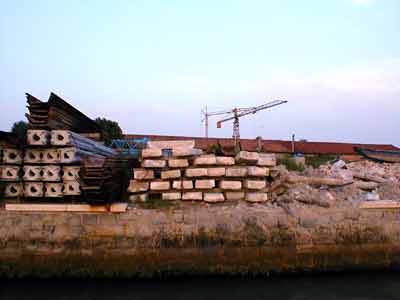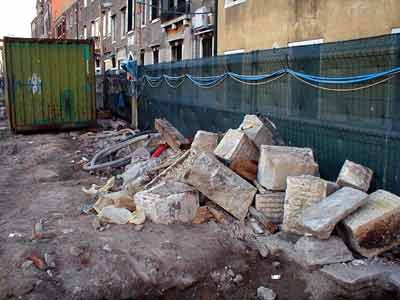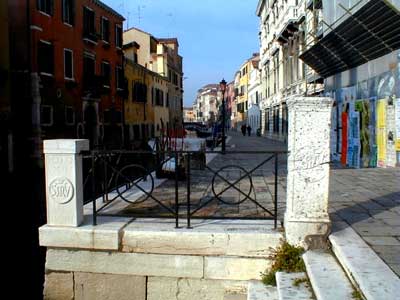
Looting of Venice, the stone from Istria
Powered by |
Saccheggio di Venezia, la pietra d'Istria Looting of Venice, the stone from Istria |
| back |
| Sostituiscono la pietra d'Istria col biancone | They substitute Istria stone with "biancone" |
|---|---|
| Da quando l'Istria ha posto severe restrizioni all'estrazione di pietra bianca, anche questo minerale è diventato molto prezioso. È una pietra dal colore bianco caldo, molto resistente agli agenti atmosferici e in particolare alla salsedine. Ha anche la caratteristica di divenire luminescente fredda in particolari condizioni di luce, come durante i temporali, quando l'atmosfera si satura di ultravioletto e luminescente calda sotto l'azione degli infrarossi come nei tramonti. In queste condizioni riveste un'importanza determinante nella creazione di quegli effetti di luce specialissimi per cui Venezia è giustamente famosa e che hanno fatto sì che la sua scuola di pittura (una delle tre maggiori italiane, con la lombarda e la toscana) fosse chiamata, appunto "della Luce". Amministratori privi di cultura e di scrupoli stanno negli ultimi anni spogliando la città di questa pietra. Migliaia di blocchi ciascuno del peso di tonnellate sono stati asportati dalle sue rive e sostituiti con un povero succedaneo, il "biancone", che dell'Istria non ha né la bellezza né la resistenza. I vecchi blocchi sono tolti dalle loro sedi e ammonticchiati come materiale da cava, per essere poi avviati, ufficialmente, in discariche. Il fondato sospetto del Comitato per la Difesa di Venezia è che invece questo materiale sia avviato a taglierie per ricavarne preziose piastrelle da arredamento. Anche qui al danno del furto, per i cittadini, si aggiunge la beffa di dover pagare i nuovi blocchi di biancone e l'umiliazione di contribuire all'arricchimento di persone e organizzazioni indegne degli incarichi loro affidati e soprattutto indegne di mettere mano alla storia di Venezia. Il primo grave episodio di asportazione della pietra d'Istria di cui ho notizia riguarda uno dei parapetti del ponte della ferrovia al tempo del raddoppio dei binari. Circa quattro Km di pietre di coronamento tagliate a mezzotondo. A seguire, qualche anno fa, tutte le pietre di sponda del canale di Cannaregio. Recentemente, anche tutte quelle delle Zattere dagli Incurabili alla Dogana e della Giudecca a Sant'Eufemia e alle Zitelle. Per Zattere e Giudecca si parla di blocchi enormi, circa cm. 70 × 120 × 40. Ma non sono solo i blocchi da riva che spariscono, sono anche centinaia di graziose colonnine da ringhiera: negli anni '80 ne sparirono circa 90 in fondamenta Ca' Balà (vedi mappa) e circa 80 in fondamenta de Borgo (vedi mappa). Un paio d'anni or sono fu la volta di fondamenta dei Tolentini, il cui scandalo è ancora in atto. |
From the time when Istria placed severe restrictions on the extraction of its white stone, that mineral became extremely precious. It is an off-white stone, very resistant to atmospheric agents, particularly salt. It also has the characteristic of becoming luminescent in particular light conditions, such as during a storm, when the atmosphere is saturated with ultra-violet rays and warm luminescence under the action of infrared at sunset. In these conditions one sees the importance of those effects which Venice is famous for, and which created a whole school of painting (one of the three major Italian schools, with Lombardy and Tuscany) which could be called "della Luce" (of the light). Administrators, lacking in culture and scruples, have during the past years stripped the city of this stone. Thousands of blocks, each weighing a ton, have been taken from the waterfronts and replaced with a poor substitute, "biancone", which, unlike Istrian stone, has neither beauty or resistance. The old blocks have been pulled from their place and piled like quarry rock, to be taken away - "officially" - to the dump. The Committee for the Defence of Venice suspects that they have been taken away and cut into tiles to be used for interior decoration. As well as the loss from theft, for Ventian citizens there is the additional mockery of the need to pay for the new blocks of white stone and the humiliation of contributing to the enrichment of people and organisations unworthy of the duties that they have been entrusted to undertake. More than ever, these people and organisations should not be allowed to meddle with, or cause further damage to, the history of Venice. The first serious episode of Istrian stone removal I am aware of is that of the stone rails along the railway bridge connecting Venice to the mainland. These were removed during the work undertaken to double the track space, and comprised approximately four kilometres of crowning stones with a half-round cut. There is then the episode of all of the side stones along the Canale di Cannaregio. And more recently, all of the side stones along the Zattere, from Incurabili to Punta della Dogana, and along the Giudecca, at Sant'Eufemia and Zitelle. Those of the Zattere and the Giudecca are very big stone blocks, about 70cms. × 120cms. × 40cms. It is not only the side stones that are disappearing. Hundreds of small pretty columns holding the rails are also missing. In the 1980s about 90 of them were taken from fondamenta Ca' Balà (see ombra.net maps), and approximately 80 from fondamenta de Borgo (see ombra.net maps). Then, three years ago, there occurred the scandal of fondamenta dei Tolentini, which is still in progress; see link below. |
Dettagli e documentazione fotografica / Details and photographic documentation
| I blocchi delle rive Edging blocks |
Lo scandalo dei Tolentini Tolentini scandal |
| Murano: grossi blocchi di pietra d'Istria depositati in un cantiere. Chissà come sono arrivati lì, e chissà dove andranno a finire? |  | Murano: large Istrian stone blocks stored in a builders yard. How did they arrive there, where are they going to, and when? |
| Giudecca: ecco come sono trattati blocchi di pietra rara vecchi di secoli: come materiale da discarica (o da cava?) |  | Giudecca: this is the way rare, centuries-old blocks of stone are treated as if they were dump - or poor quarry - material. |
| Sul pilastrino a sinistra si legge: XII M IUNII 1600 12 Mese di Giugno, ma questo pilastrino non risale certo a quell’epoca, è stato collocato nel corso dei recenti lavori, è in due pezzi uniti tra loro e alla ringhiera con stucco giallastro. La mancanza della piombatura lo sta già scheggiando malamente. |
 | On the left newel post is written: XII M IUNII 1600 12 mounth of June, but the newel post we now see there, purportedly of amazing antiquity according to the date of 1600 on it, was actually made - and placed there - in 1999.. This post now consists of two pieces jointed with yellowish epoxy putty. The omission of regular lead joints is already causing extensive damage to the post. |